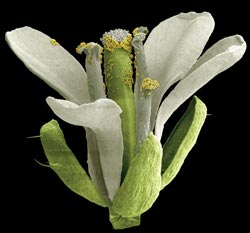Formula discovered for longer plant life

Thale cress Arabidopsis thaliana <br>Photo: Juergen Berger/ Max Planck Institute for Developmental Biology <br>
Plants that grow more slowly stay fresh longer. Scientists at the Max Planck Institute for Developmental Biology in Tuebingen have shown that certain small sections of genes, so-called microRNAs, coordinate growth and aging processes in plants.
These microRNAs inhibit certain regulators, known as TCP transcription factors. These transcription factors in turn influence the production of jasmonic acid, a plant hormone. The higher the number of microRNAs present, the lower the number of transcription factors that are active, and the smaller the amount of jasmonic acid, which is produced by the plant. The plant therefore ages more slowly, as this hormone is important for the plant's aging processes. Since the quantity of microRNAs in the plants can be controlled by genetic methods, it may be possible in future to cultivate plants that live longer and grow faster. (PLoS Biology, September 22, 2008)
MicroRNAs are short, single-strand sections of genes that regulate other genes. They do this by binding to complementary sections of the genetic material, thus preventing them from being read and implemented in genetic products. In plants, microRNAs mainly inhibit other regulators, so-called transcription factors. These factors can switch genes on or off by binding to DNA sections, thus activating or blocking them so that either too many or too few proteins are formed. Since proteins control metabolic processes, an imbalance leads to more or less clearly visible changes to the plant.
The scientists in Detlef Weigel's department at the Max Planck Institute for Developmental Biology have investigated the effects that the transcription factors of the TCP family have on the growth and aging of the model plant Arabidopsis thaliana. These transcription factors are regulated by the microRNA miR319.
It was already known that miR319-regulated transcription factors affect the growth of leaves. Using a combination of biochemical and genetic analyses, the researchers have now discovered that the transcription factors also regulate those genes that are essential for the formation of the plant hormone jasmonic acid. The higher the quantity of the microRNA miR319 present in the plant, the lower the number of transcription factors that are produced, and hence the smaller the amount of jasmonic acid, which can be synthesized. These plants have longer growth periods and age more slowly than plants that contain less miR319 and therefore have a shorter growth period but die off sooner.
“Our studies show that the transcription factors, which are regulated by the microRNA miR319, exert a negative influence on the growth of plants, and also lead to premature aging,” says Detlef Weigel. The mechanism discovered here is a further milestone in the attempt to explain the relationships of genetic regulation in plants. “Only when we have a better understanding of these processes will we be able to produce plants that have particularly desired properties,” says biologist Weigel.
Original publication:
Schommer, C., Palatnik, J.F., Aggarwal, P., Chételat, A., Cubas, P., Farmer, E.E., Nath, U., Weigel, D. (2008): Control of Jasmonate Biosynthesis and Senescence by miR319 Targets. PLoS Biology.
Contact:
Prof. Dr. Detlef Weigel
Tel: +49 (0)7071-601-1410
E-mail: Detlef.Weigel@tuebingen.mpg.de
Dr. Susanne Diederich (Press and PR Department)
Tel: +49 (0)7071-601-333
E-mail: presse@tuebingen.mpg.de
The Max Planck Institute for Developmental Biology conducts basic research in the areas of biochemistry, genetics and evolutionary biology. It has some 325 employees and is located at the Max Planck Campus in Tübingen, Germany. The MPI for Developmental Biology is one of 82 Institutes and research labs of the Max Planck Society for the Promotion of Science e.V.
Media Contact
More Information:
http://eb.mpg.deAll latest news from the category: Life Sciences and Chemistry
Articles and reports from the Life Sciences and chemistry area deal with applied and basic research into modern biology, chemistry and human medicine.
Valuable information can be found on a range of life sciences fields including bacteriology, biochemistry, bionics, bioinformatics, biophysics, biotechnology, genetics, geobotany, human biology, marine biology, microbiology, molecular biology, cellular biology, zoology, bioinorganic chemistry, microchemistry and environmental chemistry.
Newest articles

First-of-its-kind study uses remote sensing to monitor plastic debris in rivers and lakes
Remote sensing creates a cost-effective solution to monitoring plastic pollution. A first-of-its-kind study from researchers at the University of Minnesota Twin Cities shows how remote sensing can help monitor and…

Laser-based artificial neuron mimics nerve cell functions at lightning speed
With a processing speed a billion times faster than nature, chip-based laser neuron could help advance AI tasks such as pattern recognition and sequence prediction. Researchers have developed a laser-based…

Optimising the processing of plastic waste
Just one look in the yellow bin reveals a colourful jumble of different types of plastic. However, the purer and more uniform plastic waste is, the easier it is to…



